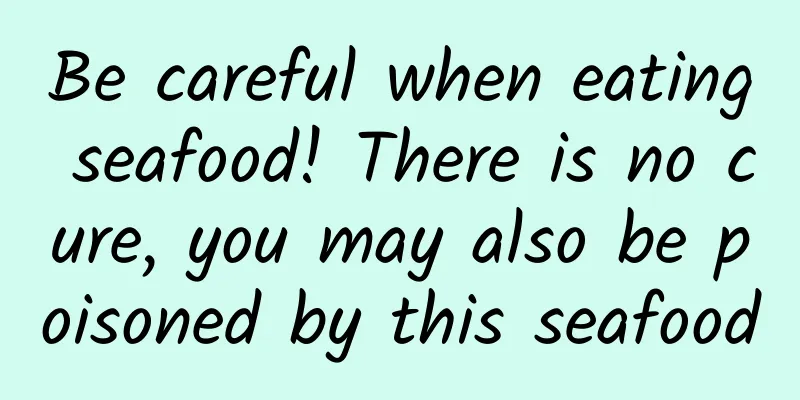Be careful when eating seafood! There is no cure, you may also be poisoned by this seafood

|
Expert in this article: Li Lin, PhD in Food Science, Professor of Zhongshan College of University of Electronic Science and Technology of China, Food Safety Expert of Zhongshan City Many people have seafood in their New Year’s Eve dinner. Seafood tastes delicious, but seafood poisoning incidents occur from time to time. In addition to the already notorious pufferfish poisoning and histamine poisoning caused by green-skinned red fish, the poisoning that causes the most cases of poisoning each year is actually Ciguatera Fish Poisoning (CFP) poisoning caused by eating reef fish. It is estimated that approximately 50,000 to 200,000 people suffer from ciguatera poisoning each year, and considering that only 2-10% of poisoning cases are reported to food control or health departments, the actual incidence is likely to be higher. If you eat a seafood dinner and start to feel dizzy, vomit, and have diarrhea, then you may have this poison. What is ciguatera toxin? Although ciguatera toxin sounds very unfamiliar, the story of poisoning caused by it was actually recorded as early as Captain Cook's story in 1774. Ciguatera toxin, also known as ciguatera toxin, is a highly harmful red tide algae toxin. It is a toxin secreted by plankton flagellate algae such as Gambierdiscus and Fukuyon that grow in tropical and subtropical areas. Small herbivorous fish living in coral reefs eat toxic algae and are then eaten by large carnivorous fish, where the toxins accumulate in the bodies of the large fish (see Figure 1). The toxins have little effect on the fish, but will eventually cause poisoning in humans through the food chain. Figure 1 Bioaccumulation of ciguatoxin (Source: Kohli, GS. et al. 2017. Qualitative and quantitative assessment of the presence of ciguatoxin, P-CTX-1B, in Spanish Mackerel (Scomberomorus commerson) from waters in New South Wales (Australia). Toxicology Report. ) Ciguatera toxin is a fat-soluble substance that is colorless and odorless. It acts on the Na+ channel on the cell membrane and can cross the blood-brain barrier into the brain, thereby affecting the central nervous system. Ciguatoxin is toxic to mammals, and its toxicity (LD50=0.25-4 μg/kg, intraperitoneal injection in mice) is greater than that of other erythrophyll toxins such as dinoflagellate toxin (LD50>100 μg/kg) and pufferfish toxin (LD50 approximately 10μg/kg). Ciguatera toxin is very stable and will not decompose in high temperature or stomach acid environments. Under frozen conditions, its toxicity can remain for at least 6 months, and it is difficult to detect its presence through conventional testing methods. Where does ciguatera poisoning mainly occur? Ciguatera toxin poisoning mainly occurs in the Pacific Ocean, Indian Ocean and Caribbean Sea, where there is plenty of sunshine and beaches. The three main areas of ciguatera toxin prevalence in the world are the former Gilbert Islands, Tokelau and Tuvalu in the South Pacific, with an annual poisoning rate of up to 100 people per 10,000 years. The U.S. Virgin Islands in the Caribbean region ranked second, with an annual poisoning rate of 73 people per 10,000 people per year. The overall prevalence of ciguatera toxin poisoning in my country is not serious. It mainly occurs in Hong Kong, Guangdong, Taiwan, Hainan and the Xisha Islands in the coastal areas of South China. The annual poisoning rate in Hong Kong is 0.17 person/10,000 person/year. What are the symptoms of ciguatera toxin poisoning? In Japan, ciguatera poisoning is often jokingly referred to as "drunk fish." This expression vividly depicts the scene of poisoning: fatigue, joint pain, and a hangover. If you touch water at this time, you will experience pain similar to electric shock. symptom Symptoms of poisoning may appear 30 minutes after eating fish containing ciguatera toxin, which may initially manifest as itching, numbness of the lips and tongue, and paralysis of the limbs. 6-17 hours later, abdominal pain, nausea, vomiting, diarrhea, and rash appear; Some people experience symptoms such as heat and cold disorders, irritability, blurred vision, and photophobia, while others experience persistent muscle and joint pain. Symptoms of poisoning usually disappear after a few days, but neurological symptoms may last for several months. No known cooking method can eliminate ciguatera toxins. Thankfully, while ciguatera toxins can affect the nervous and digestive systems, there are few reports of them being fatal. treat Treatment of ciguatera toxin poisoning mainly involves gastric lavage. If gastric lavage is not convenient, vomiting can be induced. If vomiting or diarrhea persists, fluids must be replenished promptly to prevent dehydration and electrolyte imbalance; If shock, convulsions, or breathing difficulties occur, prompt medical treatment such as the use of dextran, serum albumin, or blood transfusion is necessary. In general, there is currently no specific medicine for ciguatera toxin poisoning, and the main treatment is to reduce toxin absorption and provide auxiliary treatment for symptoms. How to avoid ciguatera toxin poisoning? The source of ciguatera toxin is a variety of benthic microalgae living near coral reefs. The living habits of toxic benthic microalgae determine that most of the fish susceptible to ciguatera toxin are coral reef fish. More than 400 species of fish are believed to contain ciguatera toxins, including the popular grouper, sea bass, snapper, perch, etc.; crabs, lobsters, sea urchins, shellfish, etc. that live in coral reefs may also contain ciguatera toxins due to eating toxic algae. There are about 45 species of coral fish that may be infected with ciguatera toxin in my country's waters, mainly distributed in Taiwan, the Xisha Islands and Hainan Island. Ciguatera toxin is the most common neurotoxicity after eating coral reef fish, but it is difficult to identify fish containing toxins from their appearance, texture and smell. Since there is no effective detection method or treatment for ciguatera toxins, the most effective way at present is to carry out community science education and try to avoid or reduce the consumption of fish containing toxins. 1. Avoid eating coral fish from certain waters Ciguatera poisoning is more likely to occur in tropical and subtropical waters between 35 degrees north and 35 degrees south latitude, such as the South Pacific and the Caribbean. Travelers to the South Pacific region or importing coral fish from the region should be particularly careful, and special attention should be paid to wild reef fish such as barracuda, grouper or red snapper in the region. 2. Reduce intake of fish species that are prone to accumulating ciguatera toxins Although the fish containing ciguatera toxin are not species-specific like pufferfish, they are mainly concentrated in coral fish such as barracuda, humphead wrasse, grouper, snapper, parrotfish, moray eel, triggerfish and amberjack. Figure 3 The six most common fish species associated with Ciguatera fish poisoning in Hong Kong (Source: Hong Kong Food Safety Center) Fortunately, ciguatera toxins rarely contaminate pelagic fish such as tuna, marlin, dolphin or other fin fish, and there have been no reports of ciguatera poisoning in farmed fish. 3. Don’t eat coral fish that are too big, and don’t eat the fish’s internal organs Generally speaking, the larger the fish, the higher the ciguatera toxin content. Poisoning occurs in large fish weighing more than 2 kilograms. Therefore, do not eat coral fish that are too large. The Spanish government has expressly prohibited the sale of fish from the Canary Islands that are larger than 14 kilograms (green fish, peace fish, and hamachi). Although all coral fish may contain ciguatera toxin, it is mainly concentrated in the head, skin and internal organs of the fish, with the highest concentrations in the liver, gonads and intestines. Therefore, when eating coral fish, do not eat the liver, intestines, eggs and head of marine fish. The pictures in this article with the "Science Popularization China" watermark are all from the copyright gallery. The pictures are not authorized for reprinting. |
<<: A self-help guide for visiting relatives during the Spring Festival
>>: Anxiety is not what you think
Recommend
A must have! 18 hot spot tracking tools for marketing and promotion operators!
"Chasing hot topics" is a common practi...
Only these five types of masks can prevent epidemics!
As masks become a must-have item when going out V...
Wan Zi Analysis of Brand Global Growth Model
Global growth is the only way for a brand. This a...
The difference between American and Japanese comics adapted movies: It turns out that the Japanese lost not only in technology
Each period of time has a special popular trend, ...
How should Xiaohongshu be operated to increase followers?
The diversity of new media platforms has made it ...
Tik Tok’s monetization and commercialization trends!
For commercial products, monetization is an unavo...
What is Baidu AiPurchasing? When did Baidu Ai Purchasing start?
Baidu Aicaigou is a B2B vertical search engine un...
Some people wear mink wraps, some wear short sleeves. How should we dress correctly in this national “random dressing season”?
The winter chill gradually fades away, and in ear...
Why is it that the rocket is fine when it flies out, but the spacecraft burns up when it comes back? The key is speed
The process of a rocket igniting and taking off f...
Why didn't a larger iPad appear this year?
In the early morning of October 17th, Beijing tim...
0-1 Product operation strategy for building a mutual financial P2P platform
Having been in the Internet finance industry for ...
Can you believe it? Mosquitoes can actually help with vaccinations!
In order to enable the body to acquire immunity t...
Inventory of Kuaishou advertising resources
1. Dual feed stream resource entry Note: The norm...
Abandoned Imagination decides to sell itself, China should take it into its pocket
Imagination, a well-known British chip manufacture...
This kind of food is recommended by the whole network in summer, but I advise you not to eat it
Summer is here, and it is a great season to eat r...









